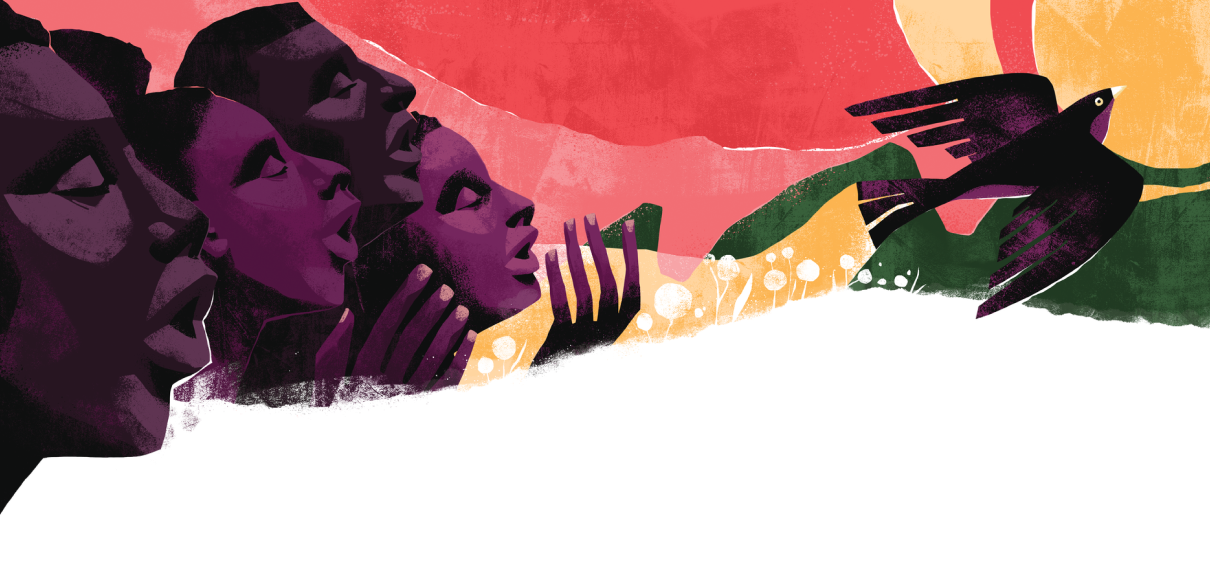Black spirituals aren’t just for Black churches. They should be sung by everyone.
It is Christmas Eve 2021, and here I am, a descendant of enslaved Africans, leading my predominantly white Presbyterian congregation in Atlanta, Georgia, in singing the Black spiritual, “Go Tell It on the Mountain.” The song is not being presented to the congregation as a performance concert piece. Instead, I’ve prepared an arrangement that allows it to be what it was always meant to be: a relational, transformative, communal act of worship that joins us together.
My great-grandfather six generations removed, Michael, who was enslaved less than 100 miles from here in Jones County, Georgia, would never have imagined such a picture. I am deeply moved and thankful for this moment in time and how far we have come. Three years before I arrived at this church, I visited the Jones County archives to research my ancestry. I found the graves of the Newby family, the white landowners in the area. I stood in front of a Newby tombstone, fists clenched and heart grieved, imagining all that my ancestors had suffered at this man’s hands. The sun was shining brightly. Even the mosquitoes were quiet. At that moment God spoke into my heart and said, “Be reconciled.”
I had already spent three decades trying to bridge divides by bringing different genres of music into conversation. But now this call to live out reconciliation with others would lead me to share my people’s music with predominantly white congregations throughout the United States and particularly here in the South. Whatever our personal histories, I can think of no better way to express our shared longing for liberation from the bonds of racism than the spirituals.
“When we sing in harmony, we become more aware of the grace that holds all creation together.” — Stephen Michael Newby
The spirituals, rich with historical, theological, and social nuance, come down to us from enslaved Africans. Many will have heard that the enslaved used spirituals to communicate messages to one another that their oppressors would not recognize. Biblical stories and theological themes often masked an underlying message: the song “Go Down, Moses” was not just about the biblical figure but was sung to signal people to prepare themselves to flee north toward freedom.
Another song, “Follow the Drinking Gourd,” literally gave directions for how to navigate northward by following the North Star. When spirituals referred to Satan, that could be code for the slave master. Songs about Jesus’ crucifixion were also about the lynchings happening within their own communities. Only those in the community would be able to recognize these encoded messages, sung right under the noses of the slave owners.
But there’s more to it than that. While the hardships of slavery, and the enslaved people’s expectations of freedom, are evident all over the spirituals, they carry significance for us as well. These are universal songs about heaven and hell, and about our spiritual captivity and liberation, that ring true far beyond their specific historical context.
The spirituals endure to this day because they are creatively and beautifully crafted songs with undeniably powerful melodies and semantics. Though now they are often sung in a minor key, historical studies suggest that while most spirituals incorporated minor chords, they consisted primarily of major chords.
Their originality is evident not just in the way the music is structured, but in the way it affects listeners. The rhythm is off the typical beat, in a way that naturally gives rise to bodily movement, inviting people to be involved in more than just a song. Perhaps this more than anything separates Black music from the hymns that white Christians were singing in church.
In his 2004 history of Black gospel music, People Get Ready, Robert Darden writes that when the enslaved were taken from their homelands and communities in Africa, there was something that the slave owners could not strip from them. They may have been language impoverished
because they were deprived of literacy, but they could pass on their stories through work songs, spirituals, and dance.
Darden points out another fascinating aspect of the spirituals: There seems in them to be no sense of historical time lapse. It is as if the singers have such a deeply personal relationship with the biblical characters that they sing directly to them.
Standing at the Newby grave, I could not escape this calling to bring people together in radical racial reconciliation through singing. I had been conducting multiethnic musical groups for 30 years, musically and spiritually sojourning, discovering the beauty of diversity as one of God’s gifts to creation.
Gathering to sing under the auspices of unity brings all those involved into a space I describe as a “mutuality of grace.” When we sing in harmony, we become more aware of the grace that holds all creation together. We engage holistically, connecting with everyone in the room as
we focus on blending our sound, adding to the collective voice.
Although I didn’t know where it would lead at the time, I stumbled upon racial reconciliation through singing as a graduate student at the University of Massachusetts at Amherst in 1986. For my master’s thesis, I composed a multiethnic, intergenerational oratorio entitled, “Be Still and Know.”
I was interested in blending gospel music and jazz in the context of theatre. I grew up in a strict Missionary Baptist tradition where playing jazz was not supported in the context of church.
I was unfamiliar with the sacred services commissioned by the Episcopal Archdiocese of San Francisco from Duke Ellington in 1965. But deep within my consciousness, I knew there was a connection between jazz and Gospel and the spirituals. I knew that fusing diverse musical elements creates something new and positive, not only in our music but in our humanity. And I knew my ancestors had practiced fusing cultures as a means of surviving and thriving.
Already at this early stage in my musical-spiritual formation, I dreamed about bringing together people from what I might call contrapuntal musical narratives. I asked myself what would happen if, among all the racial division in Detroit and its suburbs, we could get white folks and Black folks to sing together.
I decided to pursue the idea by holding gospel music workshops with churches from inner-city Detroit, the surrounding suburbs, and Ann Arbor. For more than 10 years, we had 10 to 15 churches coming together to practice racial reconciliation through singing. We visited each other’s churches. We broke bread together. We fellowshipped and built friendships that have held strong to this day.
In The Spirituals and the Blues, James H. Cone describes the spirituals as “community music.” Singing community music, we find ourselves living in community.
I believe singing spirituals allows us to transcend cultures of vitriol and racism and ascend toward citizenship in God’s kingdom. As the spiritual suggests, “all God’s children got shoes” — we are all equal in essence even if we have different roles.
When we sing our part in the great symphony of the spirituals, we transcend negativity and live together in harmony in a way that envisions God’s kingdom. Singing spirituals takes us to the mountaintop. They help us realize that all of us have been born into an oppressed state of sinfulness and that Jesus Christ lifts us up to receive the liberation God offers to all humanity.
Singing “Go Tell It on the Mountain,” on Christmas Eve reminded me of Psalm 133, the “song of ascents” that begins, “How good and pleasant it is when God’s people live together in unity!” Speaking of this psalm, Walter Brueggemann writes, “The poem anticipates the solidarity and harmony of all humanity as it lives without defensiveness in a creation benevolent enough to care for all.”
In the same way, “Go Tell It on the Mountain,” reflecting the heart language of the enslaved, invites us to join in solidarity with all creation as we live out God’s liberating kingdom here on earth. The gates of hell shall not prevail against God’s kingdom when, singing these songs of liberation and unity under the power of God’s spirit, we make a decision to ascend with Christ and to rise above cultures of disunity.
Scripture commands us to teach and admonish one another with psalms, hymns, and spiritual songs (Col. 3:16). Whatever our hermeneutics, theological constructs, or biblical interpretations might be, we can glorify God through these songs. Whether we’re Black, white, Hispanic, Asian — whatever our ethnicity or identity — when we sing the songs of those who have been enslaved, we join them in looking for liberation from being enslaved by racism.
I believe we all bleed red, and that’s the color of reconciliation. Christ shed his blood on Calvary to reconcile all creation to our Heavenly Father. When God’s people sing Black spirituals together, we identify with our deep sense of humanity, and we will want to live our lives in ways that help eradicate racism. We sing a song of ascent. We rise above our proclivities and sit in heavenly places, becoming aware that our citizenship is heaven-bound and that we must “sing and bring down” heaven to earth.
Stephen Michael Newby is a professor of music and director of composition at SPU. He is also the director of the Center for Worship.
Newby’s article, “Go Tell It on the Mountain,” is reprinted from the Spring 2022 issue of Plough Quarterly, “Why We Make Music.” Copyright © 2022 by Plough Publishing House. Reprinted with permission.
Illustration by Thiago Limón




